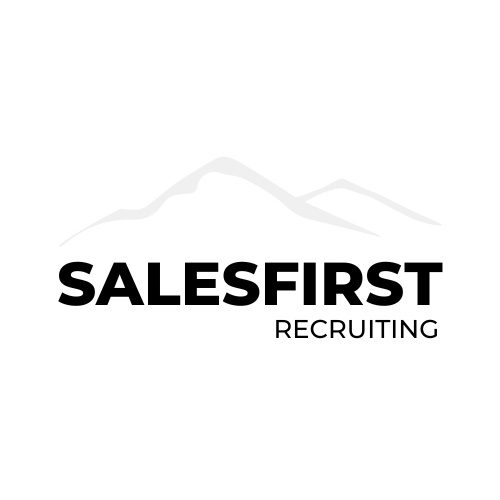How to Win Candidates Through Career Pathing
Why Career Pathing Matters to the Candidate
At SalesFirst Recruiting, we coach candidates to manage their sales careers wisely to achieve long-term success. Oftentimes, someone’s first sales job is a chance to figure out what they like, and we encourage them to level up and develop their skills toward a specific area of expertise.
We tend to see professionals move up in one of three ways:
By moving into larger market segments (Small Biz, to Mid-Market, to Enterprise, to Global)
By becoming a widely known subject matter expert for a particular industry or niche.
Or by moving into leadership or other specialized functions that support the frontlines.
At any point in a candidate’s career, you can bet that they are thinking about their earning potential, their credibility & reputation. This is especially true for a sales professional, as their compensation is typically commission-based and tied to their performance. In terms of credibility and reputation, a sales professional who values their long-term success will likely be mindful of building strong relationships with their clients, providing excellent customer service, and conducting themselves professionally in all interactions. Maintaining a positive reputation and credibility is crucial for sales professionals, as it can lead to repeat business, referrals, and ultimately, greater earning potential.
But you can also uncover - as we have- that candidates are also thinking about the vulnerabilities they have in their career. Have they insulated themselves well enough from a recession? Will automation or AI replace them? Will they eventually be forced out due to age discrimination? It really is a mix of abundance and scarcity that tends to keep professionals charging forward. And we intend to touch on all of these things to break down all sorts of barriers and attract the right talent.
Sell the Career. Not the Job.
When SalesFirst Recruiting was in its infancy, the only people we could get to come work for us were family members and recent graduates. Now, there is nothing wrong with hiring recent graduates unless you ACTUALLY need to hire more experienced professionals. Everything changed when we built a career pathing document- and the reason is because we started selling the career and not the job.
When professionals understand their opportunities for growth and development within an organization, they are more likely to feel engaged, motivated, and committed to their work. By providing a clear career pathing framework, you can help your sales candidates see a direct link between their efforts and their future success within the organization. While this might seem obvious, we don’t actually see a lot of this. Candidates don’t often get clear answers when they ask about career-pathing.
So, while your competitor is busy talking about the Account Executive position that’s open, you’ll be busy talking about your training, the promotion paths, what you need from them to become a leader in your company, and what types of commitment it takes once they get there. The conversations will feel miles apart, and you will win many more battles for the right talent.
Start by Building the Document
If you don't already have a document, now is the time to create one. Start by outlining the different paths for career progression within your organization.
Here’s an example of some typical career paths. Yours can and should look different.
Individual Contributors) SDR > Account Executive > Senior Account Executive > Enterprise Account Executive
Leadership) Sales Manager > Director of Sales > VP of Sales
Specialty) Technical Account Executive > Sales Engineer > Senior Sales Engineer
Your chart might be a table like this. Or it might be a traditional org chart. Either way, you don’t need anything too extravagant to get started. The right candidate for you is very comfortable with the realities of your company. What’s important is that you begin the work and start sharing it. Realistically, it’ll be a work-in-progress forever. We at SalesFirst built this, and while it’s really simple, a lot of thought went into it. https://www.salesfirstrecruiting.com/join-us
It highlights the benefits of working with SalesFirst Recruiting, such as flexible hours, unlimited earning potential, and career growth opportunities.
It showcases the company culture
It has a simple and easy application process
It has testimonials from current and former employees, who share their positive experiences and achievements with SalesFirst Recruiting.
Cover These Items
Expectations for Performance for Each and Every Role
First and foremost, candidates want to know what's expected of them in their most imminent role. Start there, but be sure to show them how their responsibilities increase with each promotion. Don’t be fearful about showing how lofty your expectations are. Good candidates want to understand what they need to do to succeed and what metrics they'll be measured against. By setting clear performance expectations, you can ensure that everyone on your team is working towards the same goals and contributing to the success of the company. Additionally, you’ll show your candidates that you have your stuff together and run your company well.
Clear Income Expectations
Another important factor for candidates is understanding the earning potential of their role. - Not just the role right in front of them, but all the roles after it too. They want to know what they can expect to make in terms of salary, bonuses, and other incentives. By providing transparency around compensation, you can demonstrate that you value your employees and are committed to rewarding them for their hard work. And don’t worry about whether or not that initial comp is attractive yet. The whole idea is to attract talent over what they can accomplish in the next 5-10 years, not the next 5-10 months.
Remember that job seekers are not just looking for a job that pays the bills, but for a role that aligns with their personal values and goals.
Multiple Routes for Career Progression
Show them exactly how it works- and if you aren’t there yet, show them how it COULD work. Just have it documented. Candidates want to feel like they have opportunities for growth and development within your organization. By offering multiple routes for career progression, you can demonstrate that you're invested in their long-term success. This should include opportunities for special roles, promotions to larger market segments, or leadership roles.
By outlining these milestones in advance, you can give your employees something to work towards and help them understand how they can advance within the company.
Strong Leadership
Candidates want to work for leaders who are knowledgeable, approachable, and inspiring. You’ll have years to show them exactly what type of leadership your company brings, but in the interview process, this is one heck of a way to demonstrate that all the leaders in your company have earned their stripes via completing training, hitting targets, and getting promoted.
How You’ll Help Them
A key aspect of a career pathing framework is the development of training and development programs that support employee growth and development. This can include formal training programs, on-the-job learning opportunities, and mentorship or coaching programs. You may not be in a spot yet where you have a training department, and you may not even be in a spot where you have 3rd parties who do it for you. But every company is in a spot to assign mentors, to invite people to leadership meetings, to recommend books, and to challenge professionals to grow.
Candidates want to work for companies that will help them improve their resume and advance their career. It might seem counterintuitive, but the more we ready our people to move on to bigger and better jobs, the more likely they are to stay.
There’s an old fable that is a personal favorite of ours at SalesFirst Recruiting. The original quote is attributed to several different leaders depending on what source you read, but here’s the basic fable:
A CEO and an HR leader are discussing a somewhat expensive leadership & training program. The CEO asks, "What if we train all of our people and they leave?” The HR Leader responds with, “What if we don't and they stay?"
This is the dilemma faced by many organizations when it comes to investing in employee development. On one hand, there is a fear of investing resources in an employee's training and development, only for them to leave the organization shortly afterward. On the other hand, failing to invest in employee development can be a major cause of low job satisfaction. Do it, and never look back.
Ask SalesFirst Recruiting for Help
Start attracting the right talent to your organization by implementing career pathing! SalesFirst Recruiting can help you do this and then help you find the exact talent you’re seeking. visit www.salesfirstrecruiting.com today!

